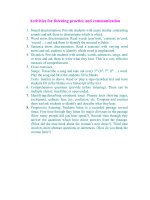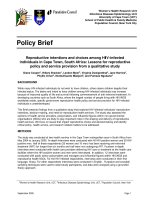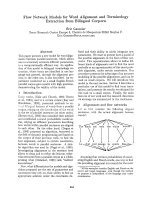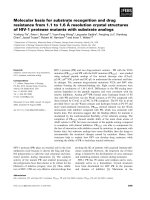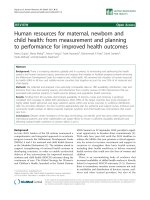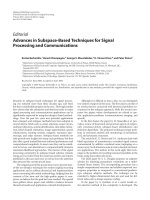IONIC LIQUIDS FOR CELLULOSE PROCESSING AND CARBON CAPTURE FROM FIRST PRINCIPLES CALCULATIONS TO ATOMISTIC SIMULATIONS
Bạn đang xem bản rút gọn của tài liệu. Xem và tải ngay bản đầy đủ của tài liệu tại đây (10.58 MB, 186 trang )
IONIC LIQUIDS FOR CELLULOSE PROCESSING
AND CARBON CAPTURE: FROM FIRST-PRINCIPLES
CALCULATIONS TO ATOMISTIC SIMULATIONS
KRISHNA MOHAN GUPTA
(B.Tech., NIT, Durgapur, India)
A THESIS SUBMITTED
FOR THE DEGREE OF DOCTOR OF PHILOSOPHY
DEPARTMENT OF CHEMICAL AND BIOMOLECULAR
ENGINEERING
NATIONAL UNIVERSITY OF SINGAPORE
2014
To My Family
&
Almighty God
Declaration
I hereby declare that the thesis is my original work and it has been written
by me in its entirety.
I have duly acknowledged all the sources of information which have been
used in this thesis.
This thesis has also not been submitted for any degree in any university
previously.
_________________
Krishna Mohan Gupta
October 2014
i
Acknowledgements
First and foremost, it is my great pleasure to extend my sincere thanks and
profound sense of gratitude to my supervisor A/Prof. Jiang Jianwen for his
invaluable guidance and unending support throughout my research. I truly
admire him for his continuous advice and moral support, and appreciate his
patience especially at time of my slow progress. As a friend-cum-supervisor,
he is constantly willing to share his knowledge and experiences that have
helped me in learning innumerable lessons both for research and daily life. I
feel privileged to be a part of his research group, which provides me the
delightful opportunity to receive continuous encouragement and meticulous
guidance during the course of my graduate studies. I will certainly try to
implement these invaluable experiences in my future endeavors.
This thesis would have not been possible without encouragement from my
lab mates. I wish to make special thanks to Dr. Hu Zhongqiao for his
comprehensive discussions and providing alternate suggestions. I feel grateful
to Dr. Anjaiah Nalaparaju, Dr. Chen Yifei, and Dr. Fang Weijie for sharing
their knowledge and helping me out on several occasions. I wish to extend my
thanks to my other group members Dr. Zhang Liling, Dr. Luo Zhonglin, Mr.
Naresh Thota and Ms. Zhang Kang for being a source of technical discussions
as well as refreshing gossips.
I would like to thank my external and internal examiners to accept the
request to examine my thesis and also provide me valuable comments. I am
thankful to A/Prof. Li Zhi and Dr. Erik Birgersson for being my examination
committee and their constructive comments during my qualifying
examination. I wish to thank Sandy for taking care of lab related issues, and
also to Yoke, Steffen, and Vanessa for helping me out in academic and
administrative matters. I highly value the support of National University of
Singapore for providing the funding and research facilities.
I want to express my special and heartfelt thanks to Ashwini, Sumit,
Shivom, and Vaibhav for taking their extra time out in memorable
conversations and energizing chitchats during entire PhD duration. I wish to
thank my friends, Manoj, Shailesh, Krishna, Naresh, Rajneesh, Praveen,
ii
Naviyn, Meiyappan, and Jaya Kumar to keep myself sane and also providing
me a wonderful atmosphere outside the research life.
Most important for me is to evince my endless gratitude to my father Late
Shree J.P. Gupta who taught me the way to come out easily from very difficult
situations. He is my real hero, inspiration, and motivator and always will be in
my heart. Indeed it would not be possible to convey my gratitude to him in
mere words. How can I forget to pass my heartfelt and unending gratitude to
my beloved mother Mrs. Sharda Devi for her inspiration, patience, moral
encouragement, and endless love and support. Specially, I remember her
sacrifice of getting up at 4.30 AM along with me to get completed my
homework when I was a kid. I further want to convey my deepest gratitude
and warmest thanks to my siblings - Mrs. Yatri Devi, Mr. S. B. Gupta, and Mr.
R.B. Gupta and all other relatives and friends for their love and cherished
moments. I will always remember the encouraging words of my brother Mr.
S.B. Gupta “(i) Due to unfortunate incident I was unable to carry forward my
higher studies, but I will not let that happen to you. ii) Never think that your
father has passed away; from now onwards, I am your both father and
brother.” The statement given by my brother Mr. R.B Gupta to other family
members “Don’t tell any bad news even the minor ones to Krishna, otherwise
his study will get affected.” will forever remind me his intense care for me. I
would also extend my heartiest thanks to my fiancée Sonam for her patience,
love and understanding. In addition, I acknowledge each and every one who
helped me to complete this thesis directly or indirectly.
Last, but most importantly, I am deeply grateful to almighty God. I would
have never completed my PhD program without His blessing and offering me
enough strength.
Krishna Mohan Gupta
iii
Table of Contents
Acknowledgements i
Table of Contents iii
Summary vii
List of Tables ix
List of Figures xi
Abbreviations xviii
List of Symbols xxi
Chapter 1. Introduction 1
1.1 Development of Ionic Liquids 1
1.2 Structures of Ionic Liquids 2
1.3 Physical and Chemical Properties of Ionic Liquids 4
1.4 Applications of Ionic Liquids 7
1.4.1 Industrial-Scale Applications 7
1.4.2 Laboratory or Pilot-Scale Applications 8
1.4.2.1 Solvents 8
1.4.2.2 Separation 9
1.4.2.3 Other Applications 9
1.5 Cellulose Dissolution/Regenration 10
1.6 CO
2
Capture 11
1.7 Objectives and Outline of the Thesis 12
Chapter 2. Literature Review 14
2.1 Cellulose Dissolution/Regeneration 14
2.1.1 Cellulose Dissolution 14
2.1.1.1 Experimental Studies 14
2.1.1.2 Theoretical Studies 19
2.1.2 Cellulose Regeneration 22
2.1.2.1 Experimental Studies 22
2.1.2.2 Theoretical Studies 22
2.2 CO
2
Capture 23
2.2.1 Experimental Studies 23
iv
2.2.2 Theoretical Studies 29
Chapter 3. Computational Methods 33
3.1. Electronic Level Methods 33
3.1.1 Ab Initio Calculation 33
3.1.2 Density Functional Theory 34
3.2 Atomic Level Methods 35
3.2.1 Monte Carlo Simulation 36
3.2.2 Molecular Dynamics Simulation 37
3.2.3 Force Fields 39
Chapter 4. Mechanistic Insights into Cellulose Dissolution in Ionic Liquids .41
4.1 Introduction 41
4.2 Simulation Models and Methods 42
4.2.1 Cellulose Crystal 42
4.2.2 Ionic Liquids 44
4.2.3 Cellulose/Solvent Systems 45
4.3 Results and Discussion 46
4.3.1 Cellulose Crystal 46
4.3.2 Ionic Liquids 50
4.3.3 Cellulose/Solvent Systems 50
4.4 Summary 54
Chapter 5. Molecular Insights into Cellulose Regeneration from
Cellulose/Ionic Liquid Mixture 56
5.1 Introduction 56
5.2 Models and Methods 56
5.3. Results and Discussion 58
5.3.1 Effect of Water Concentration 58
5.3.1.1. Radial Distribution Functions 58
5.3.1.2. Hydrogen-Bonds 62
5.3.1.3. Torsional Angle Distributions 66
5.3.2. Effect of Temperature 67
5.3.2.1. Radial Distribution Functions 67
5.3.2.2. Number of Contacts 68
v
5.4. Summary 69
Chapter 6. Role of Anti-Solvents in Cellulose Regeneration from
Cellulose/Ionic Liquid Mixture 71
6.1 Introduction 71
6.2 Models and Methods 71
6.2.1. Cellulose/[BMIM][Ac]/Solvent Systems 71
6.2.2. Ab Initio Calculations 73
6.3 Results and Discussion 74
6.3.1. Radial Distribution Functions 74
6.3.2 Hydrogen-Bonds 76
6.3.3. Dynamic Properties 79
6.4. Summary 82
Chapter 7. IRMOF-1-Supported Ionic Liquid Membranes for CO
2
/N
2
Separation 84
7.1 Introduction 84
7.2 Models and Methods 85
7.2.1 Ionic Liquids 85
7.2.2 Binding Energies between Anions and CO
2
87
7.2.3 IL/IRMOF-1 Membranes 87
7.2.4 Adsorption and Diffusion of CO
2
/N
2
Mixture 89
7.3. Results and Discussion 90
7.3.1 Densities of ILs 90
7.3.2 Structures of ILs in IL/IRMOF-1 Membranes 91
7.3.3 Limiting Selectivities of CO
2
/N
2
Mixture 96
7.3.4 Separation of CO
2
/N
2
Mixture in [BMIM][SCN]/IRMOF-1
Membrane 98
7.4. Summary 103
Chapter 8. Hydrophobic/Hydrophilic MOFs-Supported Ionic Liquid
Membranes for CO
2
/N
2
Separation 105
8.1 Introduction 105
8.2. Models and Methods 105
8.2.1 MOF-Supported [BMIM][SCN] Membranes 105
8.2.2 Adsorption, Diffusion and Permeation of CO
2
/N
2
Mixture 109
8.3. Results and Discussion 110
vi
8.3.1 Structures of [BMIM][SCN] in Membranes 110
8.3.2 Separation of CO
2
/N
2
Mixture 113
8.4 Summary 118
Chapter 9. Systematic Investigation of Nitrile-Based Ionic Liquids for CO
2
Capture 120
9.1 Introduction 120
9.2. Models and Methods 121
9.2.1 Atomistic Models 121
9.2.2 Molecular Dynamics Simulations 122
9.2.3. Ab Initio Calculations 124
9.3. Results and Discussion 124
9.3.1. IL Systems 124
9.3.2. CO
2
/IL Systems 127
9.3.3. CO
2
nion and Cationnion Binding Energies 131
9.4. Summary 134
Chapter 10. Conclusions and Future Work 135
10.1 Conclusions 135
10.2 Future Work 138
Bibliography 141
Journal Publications 160
Conference Contributions 161
vii
Summary
In the recent years, increased energy demand and severe global warming
are two major but contradictory challenges. Fossil fuels (coal, oil, and gas) are
supplying nearly 85% of total energy demand and their combustion releases
approximately 30 gigatons per year of CO
2
into the atmosphere. In this
perspective, there has been considerable interest in search of environmentally
benign energy sources and capturing CO
2
to reduce global warming. As the
most abundant, biodegradable, natural material on the earth, cellulose is
considered to be a viable energy source to produce biofuels (a class of
renewable fuels). However, cellulose is not readily dissolve/regenerate in
common solvents due to the highly ordered structure and complex hydrogen-
bonding network. In this context, ionic liquids (ILs) as a unique class of green
solvents have been considered promising solvents for both cellulose
processing (energy surrogate) and CO
2
capture (counter global warming).
Though a number of experimental and simulation studies have been
reported, fundamental understandings of cellulose processing and CO
2
capture
in ILs are elusive and act as a practical bottleneck toward the pathway from
laboratory synthesis and testing to industrial utilization. With rapid growth in
computer power, molecular computation has emerged as a robust tool for
materials characterization, screening and design. Starting from a molecular
level, it can provides microscopic insight that otherwise is experimentally
inaccessible.
The objectives of this thesis are to quantitatively understand, from
computational approach, the underlying physics of cellulose processing
(dissolution/regeneration) and CO
2
capture in ILs. The whole thesis consists of
three parts. Firstly, the mechanisms of cellulose dissolution/regeneration in
ILs are unraveled. Towards this end, three solvents including [BMIM][PF
6
],
[BMIM][Ac] and water are examined. Upon contact with solvents, the number
of inter-chain H-bonds at the cellulose surface are found to decrease,
particularly in [BMIM][Ac]. Furthermore, cellulose regeneration is
investigated from cellulose/[BMIM][Ac] mixture using water as anti-solvent.
With increasing water concentration, the number of cellulose-[Ac]
H-bonds
viii
decreases, while the number of cellulose-cellulose H-bonds increases
resulting cellulose regeneration. Cellulose regeneration is found to be
prompted at a higher temperature. Thereafter, the role of different anti-
solvents (water, ethanol, and acetone) is examined for cellulose regeneration.
Insightful structural and dynamic properties at a microscopic level reflect that
water is a better candidate, rather than ethanol and acetone. Overall, the
computational results reveal that H-bonds are critical to govern cellulose
dissolution/regeneration.
Secondly, as a novel class of porous materials, metal-organic frameworks
(MOFs) are used as solid supports to produce IL membranes for CO
2
capture.
Initially, four ILs ([BMIM][PF
6
], [BMIM][BF
4
], [BMIM][Tf
2
N], and
[BMIM][SCN]) are supported on IRMOF-1, and CO
2
/N
2
separation is studied.
In each membrane, the limiting selectivity of CO
2
/N
2
at infinite dilution is
found to enhance with increasing the weight ratio of IL to IRMOF-1. Among
examined membranes, [BMIM][SCN]/IRMOF-1 is identified as the best
candidate. Furthermore, CO
2
/N
2
separation has been simulated in
[BMIM][SCN] membranes supported on two different MOFs (hydrophobic
ZIF-71 and hydrophilic Na-rho-ZMOF). The results reveal that the
hydrophilic support (Na-rho-ZMOF) outperforms the hydrophobic counterpart
(ZIF-71) in separation performance.
Finally, aiming to provide microscopic insight into effect of nitrile (-CN)
groups for CO
2
sorption and diffusion, four ILs namely, [BMIM][SCN],
[BMIM][N(CN)
2
], [BMIM][C(CN)
3
], and [BMIM][B(CN)
4
] are considered.
Both solubility and diffusivity of CO
2
increase with increasing number of –CN
groups. Thus, [BMIM][B(CN)
4
] appears to be the best among the four ILs for
CO
2
capture.
Overall, this thesis aims to provide microscopic insights into cellulose
dissolution/regeneration and CO
2
capture in ILs. It is revealed that H-bonding
is crucial to govern both cellulose dissolution and regeneration, and would
facilitate the development of new ILs for cellulose processing. Additionally,
CO
2
separation from flue gas in MOF-supported IL membranes surpassed the
Robeson’s upper bound. Therefore, MOF-supported IL membranes are
recommended as novel and promising candidate for CO
2
capture.
ix
List of Tables
Table 2.1. Cellulose dissolution in ILs. 15
Table 2.2. CO
2
sorption in ILs. 24
Table 4.1. Atomic charges in a glucose unit of cellulose 43
Table 4.2. Atomic charges in [BMIM]
+
, [PF
6
]ˉ, and [Ac]ˉ 45
Table 4.3. Density and lattice constants of cellulose crystal. 47
Table 4.4. Occurrence of H-bonds in cellulose crystal. 48
Table 4.5. Densities (kg/m
3
) of [BMIM][PF
6
] and [BMIM][Ac]. 50
Table 4.6. Numbers of H-bonds at the surface layer of cellulose crystal in
cellulose/solvent systems. 54
Table 5.1. Simulation systems (cellulose/[BMIM][Ac]/water mixtures). 57
Table 6.1. Atomic charges in ethanol and acetone. 72
Table 6.2. Simulation systems (cellulose/[BMIM][Ac]/solvent mixtures). 73
Table 6.3 Parameters to fit the survival time-correlation function data for
[Ac]
around cellulose. 80
Table 6.4. Parameters to fit the survival time-correlation function data for
solvent around cellulose and [Ac]
respectively. 81
Table 7.1. Atomic charges in [BMIM]
+
, [PF
6
]
, [BF
4
]
, [Tf
2
N]
and [SCN]
. 86
Table 7.2. Densities (kg/m
3
) of ILs from simulation and experiment. 90
Table 7.3. Solubility coefficients [cm
3
(STP)/cm
3
(membrane)(cmHg)],
diffusion coefficients (10
6
cm
2
/s), and permeabilities (barrer) of
CO
2
and N
2
in [BMIM][SCN]/IRMOF-1 at W
IL/IRMOF-1
= 1.0. Note
that 1 barrer = 10
-10
[cm
3
(STP)∙cm]/(cm
2
·s∙cmHg)]. 101
Table 8.1. Lennard-Jones parameters of the framework atoms in ZIF-71 and
rho-ZMOF…………………………… ………………… ……106
Table 8.2. Lennard-Jones parameters of CO
2
and N
2
. 109
Table 8.3. Solubility coefficients [cm
3
(STP)/cm
3
(membrane)(cmHg)],
diffusion coefficients [10
-6
cm
2
/s], and permeabilities (barrer) of
CO
2
and N
2
in [BMIM][SCN]/ZIF-71. 116
Table 8.4. Solubility coefficients [cm
3
(STP)/cm
3
(membrane)(cmHg)],
diffusion coefficients [10
-6
cm
2
/s], and permeabilities (barrer) of
CO
2
and N
2
in [BMIM][SCN]/ZMOF. 117
x
Table 9.1. Atomic charges of [N(CN)
2
]
[C(CN)
3
]
and [B(CN)
4
]
122
Table 9.2. Numbers of IL and CO
2
, cell dimensions in CO
2
/IL systems to
examine CO
2
sorption. 124
Table 9.3. Numbers of IL and CO
2
in CO
2
/IL systems to examine CO
2
diffusion. 124
Table 9.4. Densities of ILs at 298 K and 1 atm. 125
Table 9.5. Diffusivities of cation and anion at 400 K. 127
xi
List of Figures
Figure 1.1. Number of publications with term “ILs”. 2
Figure 1.2. Typical cations of ILs. 3
Figure 1.3. Atomic types in imidazoliun cation. 6
Figure 1.4. Potential application of ILs. 8
Figure 1.5. Cellulose network in plant biomass. 11
Figure 4.1. A unit cell of cellulose crystal viewed on different planes. Color
code: C, grey; O, red; H, white. 41
Figure 4. 2. Atomic types in a glucose unit of cellulose. 43
Figure 4.3. Cation [BMIM]
+
and anions [PF
6
]ˉ and [Ac]ˉ. 44
Figure 4.4. Cellulose/solvent systems with three different solvents (a)
[BMIM][PF
6
], (b) [BMIM][Ac], and (c) water. 46
Figure 4.5. Intra-chain O2H2∙∙∙O6 and O3H3∙∙∙O5 contacts and inter-chain
O6H6∙∙∙O3 and O6H6∙∙∙O2 contacts in cellulose crystal. 48
Figure 4.6. Variations of lattice constants of cellulose crystal in the A and B
directions as a function of temperature difference. The reference
temperature is 300 K. 49
Figure 4.7. Stress as a function of strain in cellulose crystal along the C
direction. 50
Figure 4.8. Density profiles of solvents as a function of distance from the
cellulose surface in cellulose/solvent systems (a) [BMIM][PF
6
],
(b) [BMIM][Ac], and (c) water. 51
Figure 4.9. Schematic representation of cellulose/solvent system. At the
surface layer of cellulose, five CL1 chains exist along the B
direction and are in direct contact with solvent. 51
Figure 4.10. Intra-chain O2H2∙∙∙O6 H-bonds at the bulk and surface layers of
cellulose in cellulose/solvent systems (a) [BMIM][PF
6
], (b)
[BMIM][Ac], and (c) water. 52
Figure 4.11. Intra-chain O3H3∙∙∙O5 H-bonds at the bulk and surface layers of
cellulose in cellulose/solvent systems (a) [BMIM][PF
6
], (b)
[BMIM][Ac], and (c) water. 53
xii
Figure 4.12. Inter-chain O6H6∙∙∙O3 H-bonds at the bulk and surface layers of
cellulose in cellulose/solvent systems (a) [BMIM][PF
6
],
(b)
[BMIM][Ac], and (c) water. 53
Figure 5.1. Structures of (a) cellulose chain, (b) [BMIM]
+
, (c) [Ac]
and (d)
water. N: blue, C: cyan, H: white and O: red. 57
Figure 5.2. Radial distribution functions for cellulose around (a) OA and OB
atoms of [Ac]
, (b) C1 atom of [BMIM]
+
, and (c) O
W
atom of
water in cellulose/[BMIM][Ac]/water mixtures at 0, 20, 50, and
80 wt% water. 59
Figure 5.3. Radial distribution functions between cellulose chains in
cellulose/[BMIM][Ac]/water mixtures at 0, 20, 50, and 80 wt%
water. 60
Figure 5.4. Radial distribution functions of C1 atom of [BMIM]
+
around OA
and OB atoms of [Ac]
in cellulose/[BMIM][Ac]/water mixtures
at 0, 20, 50, and 80 wt% water. 61
Figure 5.5. Radial distribution functions of O
W
atom of water around (a) OA
and OB atoms of [Ac]
and (b) C1 atom of [BMIM]
+
in
cellulose/[BMIM][Ac]/water mixtures at 20, 50, and 80 wt%
water. 61
Figure 5.6. Numbers of H-bonds between cellulose and [Ac]
in
cellulose/[BMIM][Ac]/water mixtures at 0, 20, 50, and 80 wt%
water. 62
Figure 5.7. Numbers of H-bonds between cellulose chains in
cellulose/[BMIM][Ac]/water mixtures at 0, 20, 50, and 80 wt%
water. 63
Figure 5.8. Numbers of (a) intra-chain and (b) inter-chain H-bonds between
cellulose chains in cellulose/[BMIM][Ac]/water mixtures at 0, 20,
50, and 80 wt% water. 63
Figure 5.9. Numbers of H-bonds (a) [Ac]
water per [Ac]
and (b) cellulose-
water per cellulose in cellulose/[BMIM][Ac]/water mixtures at 20,
50, and 80 wt% water. 64
Figure 5.10. Initial and final configurations in cellulose/[BMIM][Ac]/water
mixtures at (a) 0, (b) 20, (c) 50, and (d) 80 wt% water. For clarity,
xiii
cellulose and anions in (a), and cellulose and water molecules in
(b-d) are shown. 65
Figure 5.11. Proposed mechanism for cellulose regeneration by adding water
in cellulose/[BMIM][Ac] mixture. C: cyan, H: white, O: red. 66
Figure 5.12. (a) Staggered orientations of hydroxymethyl groups. Torsional
angle distributions for (b) cellulose in
cellulose/[BMIM][Ac]/water mixture at 80 wt% water and (c)
cellulose in Iβ crystal. 67
Figure 5.13. Radial distribution functions for cellulose around (a) OA and OB
atoms of [Ac]
, (b) C1 atom of [BMIM]
+
, and (c) O
W
atom of
water in cellulose/[BMIM][Ac]/water mixture at 50 wt% water,
and 40, 60, and 80 ºC 68
Figure 5.14. Radial distribution functions between cellulose chains in
cellulose/[BMIM][Ac]/water mixture at 50 wt% water, and 40, 60,
and 80 ºC. 68
Figure 5.15. Numbers of contacts between cellulose chains in
cellulose/[BMIM][Ac]/water mixture at 50 wt% water, and 40, 60,
and 80 ºC. 69
Figure 6.1. Atomic structures of (a) cellulose chain, (b) [BMIM]
+
, (c) [Ac]
,
(d) water, (e) ethanol, and (f) acetone. N: blue, C: cyan, O: red,
and H: white. 72
Figure 6.2. Radial distribution functions for cellulose around (a) OA and OB
atoms of [Ac]
, (b) C1 atom of [BMIM]
+
in the
cellulose/[BMIM][Ac]/solvent mixtures. 75
Figure 6.3. Radial distribution functions between cellulose chains in the
cellulose/[BMIM][Ac]/solvent mixtures, with cellulose chains
represented by (a) H3 atoms (b) H2 atoms, and (c) H6 atoms,
respectively. 75
Figure 6.4. Numbers of H-bonds between cellulose and [Ac]
in the
cellulose/[BMIM][Ac]/solvent mixtures. 76
Figure 6.5. Numbers of H-bonds between cellulose chains in the
cellulose/[BMIM][Ac]/solvent mixtures. 77
xiv
Figure 6.6. Initial and final configurations in the
cellulose/[BMIM][Ac]/solvent mixtures (a) water, (b) ethanol, and
(c) acetone. . 78
Figure 6.7. Optimized structures and binding energies (kJ/mol) of [Ac]
with
(a) water, (b) ethanol, and (c) acetone. The electrostatic potential
map is in atomic unit (au). 78
Figure 6.8. (a) Survival time-correlation functions of [Ac]
around cellulose
(b) mean-squared displacements of [Ac]
in
cellulose/[BMIM][Ac]/solvent mixtures. 79
Figure 6.9. Survival time-correlation functions of solvents around (a) cellulose
and (b) [Ac]
in cellulose/[BMIM][Ac]/solvent mixtures. 81
Figure 6.10. Mean-squared displacements of solvents in
cellulose/[BMIM][Ac]/solvent mixtures. 82
Figure 7.1. Cation [BMIM]
+
and anions [BF
4
]
, [PF
6
]
, [Tf
2
N]
and [SCN]
. 85
Figure 7.2. (a) IRMOF-1 structure. (b) Atomic types and charges. Color code:
Zn, orange; O, red; C, grey; H, white. 88
Figure 7. 3. [BMIM][SCN]/IRMOF-1 membrane at a weight ratio W
IL/IRMOF-1
= 0.4. N: blue, C of [BMIM]
+
: green, S: yellow, C of [SCN]¯:
pink, H: white, Zn: orange, O: red, C of IRMOF-1: grey. 88
Figure 7.4. Radial distribution functions of (a) anion and (b) cation around Zn
atom of IRMOF-1 in IL/IRMOF-1 membranes at W
IL/IRMOF-1
=
0.4. 92
Figure 7.5. Radial distribution functions of (a) anion and (b) cation around O
1
atom of IRMOF-1 in IL/IRMOF-1 membranes at W
IL/IRMOF-1
= 0.4
92
Figure 7.6. Radial distribution functions of (a) anion and (b) cation around C
3
atom of IRMOF-1 in IL/IRMOF-1 membranes at W
IL/IRMOF-1
=
0.4. 93
Figure 7.7. Radial distribution functions of (a) anion and (b) cation around O
2
atom of IRMOF-1 in IL/IRMOF-1 membranes at W
IL/IRMOF-1
=
0.4. 93
Figure 7.8. Radial distribution functions of anion-cation in (a) IL/IRMOF-1
membranes at W
IL/IRMOF-1
= 0.4 (b) bulk phase. 94
xv
Figure 7.9. Radial distribution functions of anion-anion in (a) IL/IRMOF-1
membranes at W
IL/IRMOF-1
= 0.4 (b) bulk phase. 95
Figure 7.10. Radial distribution functions of cation-cation of ILs in (a)
IL/IRMOF-1 membranes at W
IL/IRMOF-1
= 0.4 (b) bulk phase. 95
Figure 7.11. Radial distribution functions of [SCN]ˉ around (a) Zn (b) C
3
atoms of IRMOF-1 in [BMIM][SCN]/IRMOF-1 membranes at
W
IL/IRMOF-1
= 0.4 , 0.75, and 1.0. 96
Figure 7.12. Optimized structures and binding energies (kJ/mol) of CO
2
with
anions (a) [Tf
2
N]
, (b) [PF
6
]
, (c) [BF
4
]
, and (d) [SCN]
. 97
Figure 7.13. Limiting selectivities of CO
2
/N
2
mixture in IL/IRMOF-1
membranes at W
IL/IRMOF-1
= 0.4, 0.75 and 1.0, respectively. 98
Figure 7.14. Adsorption isotherms of CO
2
/N
2
mixture in
[BMIM][SCN]/IRMOF-1 at W
IL/IRMOF-1
= 1.0. The pressure
refers to the total pressure of CO
2
and N
2
mixture with a
composition of 15:85. 98
Figure 7.15. Radial distribution functions of CO
2
around N and S atoms of
[SCN]
, N
1
and N
2
atoms of [BMIM]
+
, Zn and C
3
atoms of
IRMOF-1 in [BMIM][SCN]/IRMOF-1 at W
IL/IRMOF-1
= 1.0. 99
Figure 7.16. Diffusion coefficients of CO
2
/N
2
mixture in
[BMIM][SCN]/IRMOF-1 at W
IL/IRMOF-1
= 1.0. 100
Figure 7.17. Permeation, adsorption, and diffusion selectivities of CO
2
/N
2
mixture in [BMIM][SCN]/IRMOF-1 at W
IL/IRMOF-1
= 1.0. 102
Figure 7.18. CO
2
/N
2
permeation selectivity versus CO
2
permeability. The
filled circles are in [BMIM][SCN]/IRMOF-1 of this study. The
red circles are experimental data in polymer membranes and the
line is the Robeson’s upper bound.
289
Also illustrated are the
data in polymer-supported ILs. 103
Figure 8.1. Crystal structures of (a) ZIF-71 and (b) Na-rho-ZMOF. N: blue, C:
grey, H: white, Zn: orange, Cl: light green, O: red, In: green,
Na
+
: purple 106
Figure 8.2. Pore morphologies and radii in (a) ZIF-71 and (b) Na-rho-ZMOF.
106
xvi
Figure 8.3. Atomic charges in the fragmental clusters of (a) ZIF-71 and (b)
rho-ZMOF. 107
Figure 8.4. (a) [BMIM][SCN]/ZIF-71 and (b) [BMIM][SCN]/ZMOF
membranes at a weight percentage W
IL/MOF
= 0.15. C of
[BMIM]
+
and framework: grey, C of [SCN]
: cyan, S: yellow,
N: blue, Zn: orange, Cl: light green, In: green, Na
+
: purple, O:
red, H: white. The metal clusters are shown as polyhedra. 108
Figure 8.5. Radial distribution functions of (a) [SCN]
and (b) [BMIM]
+
around the Zn, Cl, and N atoms of ZIF-71 in
[BMIM][SCN]/ZIF-71. 110
Figure 8.6. Radial distribution functions of cation-anion, anion-anion, and
cation-cation in [BMIM][SCN]/ZIF-71. 111
Figure 8.7. Radial distribution functions of cation–anion, anion–anion, and
cation–cation in bulk phase of [BMIM][SCN]. 111
Figure 8.8. Radial distribution functions of (a) [SCN]
and (b) [BMIM]
+
around the In, O, N, and Na
+
of Na-rho-ZMOF in
[BMIM][SCN]/ZMOF. 112
Figure 8.9. Radial distribution functions of cation-anion, anion-anion, and
cation-cation in [BMIM][SCN]/ZMOF. 113
Figure 8.10. Adsorption isotherms of CO
2
/N
2
mixture (15:85) in (a)
[BMIM][SCN]/ZIF-71 and (b) [BMIM][SCN]/ZMOF. 114
Figure 8.11. Radial distribution functions of CO
2
around the S and N atoms of
[SCN]
, the N
1
and N
2
atoms of [BMIM]
+
(a) the Zn and Cl
atoms of ZIF-71 in [BMIM][SCN]/ZIF-71 (b) the In and Na
atoms of ZMOF in [BMIM][SCN]/ZMOF. The total pressure of
CO
2
/N
2
mixture is 100 kPa. 114
Figure 8.12. Diffusion coefficients of CO
2
/N
2
mixture (15:85) in (a)
[BMIM][SCN]/ZIF-71 and (b) [BMIM][SCN]/ZMOF. 115
Figure 8.13. Adsorption, diffusion and permeation selectivities of CO
2
/N
2
mixture in (a) [BMIM][SCN]/ZIF-71 and (b)
[BMIM][SCN]/ZMOF. 117
Figure 8.14 CO
2
/N
2
permselectivity versus CO
2
permeability in MOF-
supported IL membranes. The red circles are experimental data
xvii
in polymer membranes and the line is Robeson’s upper
bound.
289
Also illustrated are the data in polymer-supported
ILs.
300
118
Figure 9.1. Structures of [BMIM]
+
, [SCN]
, [N(CN)
2
]
, [C(CN)
3
]
, and
[B(CN)
4
]
. N: blue, C: cyan, O: red, S: yellow, B: pink, H:
white. 121
Figure 9.2. A typical simulation cell for CO
2
/IL system to examine CO
2
sorption. 123
Figure 9.3. Radial distribution functions in ILs at 298 K (a) cationanion (b)
cationcation and (c) anionanion. 125
Figure 9.4. Mean-squared displacements of (a) anions (b) cation in ILs . 126
Figure 9.5. Density profiles of CO
2
in CO
2
/IL systems along the y-axis. The
top illustrates a typical simulation snapshot at equilibrium. 128
Figure 9.6. Density profiles of cation and anions in (a) CO
2
/[BMIM][SCN],
(b) CO
2
/[BMIM][N(CN)
2
], (c) CO
2
/[BMIM][C(CN)
3
] and (d)
CO
2
/[BMIM][B(CN)
4
]. The cation is represented by C
4
, C
6
, C
7
and C
8
atoms, and the anion by N atom. 129
Figure 9.7. Diffusivities of CO
2
in ILs. 130
Figure 9.8. Potential of mean force for CO
2
moving from gas phase into
[BMIM][B(CN)
4
]. The dotted line represents the CO
2
/IL
interface 131
Figure 9.9. Radial distribution functions for CO
2
around [BMIM]
+
and
[B(CN)
4
]
in CO
2
/[BMIM][B(CN)
4
] system. 131
Figure 9.10. Optimized configurations and binding energies (kJmol
-1
) of CO
2
with [SCN]
, [N(CN)
2
]
, [C(CN)
3
]
, and [B(CN)
4
]
132
Figure 9.11. Optimized configurations and binding energies (kJmol
-1
) of
[BMIM]
+
with [SCN]
, [N(CN)
2
]
, [C(CN)
3
]
, and (d) [B(CN)
4
]
133
xviii
Abbreviations
ILs Ionic liquids
RTILs Room temperature ionic liquids
[AMIM]
+
1-n-allyl-3-methylimidazolium
[EMIM]
+
1-n-ethyl-3-methylimidazolium
[ProMIM]
+
1-n-propyl-3-methylimidazolium
[BMIM]
+
1-n-butyl-3-methylimidazolium
[PMIM]
+
1-n-pentyl-3-methylimidazolium
[HMIM]
+
1-n-hexyl-3-methylimidazolium
[HeMIM]
+
1-n-heptyl-3-methylimidazolium
[OMIM]
+
1-n-octyl-3-methylimidazolium
[NMIM]
+
1-n-nonyl-3-methylimidazolium
[BDMIM]
+
1-n-butyl-dimethylimidazolium
[ADMIM]
+
1-n-allyl-2,3-dimethylimidazolium
[DMIM]
+
1,3-dimethylimidazolium
[DBIM]
+
1,3-dibutylimidazolium
[HMMIM]
+
2,3-dimethyl-1-hexylimidazolium
[NC-C
3
MIM]
+
1-Butanenitrile-3-methylimidazolium
[B(C
3
HF
6
)IM]
+
3-butyl-1-(1,1,2,3,3,3-hexafluoropropyl)-imidazolium
[Me(OEt)
2
-Et-Im]
+
1-ethyl-3-(2-methoxyethoxy)ethyl)imidazolium
[Me(OEt)
3
-Et-Im]
+
1-ethyl-3-(2-(2-methoxyethoxy)ethoxy)ethyl)
imidazolium
[Me(OEt)
4
-Et-Im]
+
1-ethyl-3-(2-(2-(methoxyethoxy)ethoxy)ethoxy)ethyl
imidazolium
[Me(OEt)
2
-Et
3
N]
+
Triethyl (2-methoxyethoxy)ethylammonium
[Me(OEt)
3
-Et
3
N]
+
Triethyl (2-(2-methoxyethoxy)ethoxy)
ethylammonium
[H(OEt)
2
-Me-Im]
+
1-(2-(2-hydroxylethoxy)ethyl)-3-methylimidazolium
[H(OEt)
3
-Me-Im]
+
1-(2-(2-(2-hydroxylethoxy)ethoxy)ethyl)-3-
methylimidazolium
[Me(OEt)
2
-Et-Pip]
+
N-ethyl-N-(2-methoxyethoxy)ethylpiperidinium
[N-bupy]
+
N-butylpyridinium
[BMpy]
+
3-Methyl-N-butyl-pyridinium
[C
4
Py]
+
1-butylpyridinium
xix
[P66614]
+
Trihexyl tetradecyl phosphonium
[TMGH]
+
N,N,N,N-tetramethylguanidium
[BF
4
]
Hexafluoroborate
[PF
6
]
Hexafluorophosphate
[Ac]
Acetate
[Tf
2
N]
Bis[(trifluoromethyl)sulfonyl]amide
[CF
3
COO]
Trifluoroacetate
[EtCO
2
]
Propionate
[HCOO]
Formate
[H
2
NCH
2
COO]
Aminoethanic acid
[HOCH
2
COO]
Glycollate
[CH
3
CHOHCOO]
Lactate
[(C
6
H
5
)COO]
Benzoate
[Cl]
Chloride
[Br]
Bromide
[CN]
Cyanide
[SCN]
Thiocyanate
[N(CN)
2
]
Dicyanamide
[C(CN)
3
]
Tricyanomethane
[B(CN)
4
]
Tetracyanoborate
[NO
3
]
Nitrate
[ClO
4
]
Perchlorate
[Fe(Cl)
4
]
Tetrachloroferrate
[Al(Cl)
4
]
Tetrachloroaluminate
[TfO]
Trifluoromethanesulfonate
[H
2
PO
4
]
Dihydrogen phosphate
[(MeO)MePO
2
]
Methyl methylphosphonate
[(MeO)HPO
2
]
Methylphosphonate
[(MeO)
2
PO
2
]
Dimethylphosphate
[Et
2
PO
4
]
Diethylphosphate
[eFAP]
Tris(pentafluoroethyl)trifluorophosphate
[pFAP]
Tris(heptafluoropropyl)trifluorophosphate
xx
[bFAP]
Tris(nonafluorobutyl)trifluorophosphate
[HSO
4
]
Sulphate
[EtSO
4
]
Ethyl sulfate
[MeSO
4
]
Methyl sulfate
[MeSO
3
]
Methanesulfonate
EtOH Ethyl alcohal
THF Tetrahydrofuran
DMSO Dimethyl sulfoxide
DMF Dimethyl formamide
DMA Dimethylacetamide
SILMs Supported ionic liquid membranes
MOF Metal-organic frame work
IRMOF Isoreticular metal-organic frame work
DFT Density Functional Theory
MC Monte Carlo
GCMC Grand Canonical Monte Carlo
MD Molecular Dynamics
B3LYP Becke’s three parameter, Lee, Yang and Parr
MP2 Second order Møller–Plesset
LJ Lennard-Jones
AMBER Assisted Model Building with Energy Refinement
MSD Mean-squared displacement
H-bond Hydrogen-bond
xxi
List of Symbols
H
Hamiltonian operator
V
potential energy of particle
particle wave function
r
coordinate vector
h Planck’s constant
ρ electron density
K kinetic energy
V
ext
energy due to interaction with external potential
V
ee
electron-electron interaction energy
i
determinant wavefunction of orbital i
E
xc
exchange-correlation energy
β Boltzmann’s constant
N number of atoms or molecules
f fugacity
u
i
potential energy of the particle i
m
i
mass of the particle i
a
i
, acceleration the particle i
v
i
,
velocity of the particle i
total
u
total potential
bonded
u
potential due to the interaction of bonded atoms
nonbonded
u
potential due to the interaction of nonbonded atoms
stretching
u
potential due to the bond-stretching in bonded atoms
bending
u
potential due to the angle-bending in bonded atoms
proper
u
potential due to the proper torsionals in bonded atoms
improper
u
potential due to the improper torsionals in bonded atoms
b
k
&
k
force constants of bond-stretching and angle-bending potentials
C
n
&
k
force constants of proper and improper torsional potentials
ij
b
bond distance between atoms i and j
xxii
ijk
angle by atoms i, j and k
ijkl
&
ijkl
proper and improper torsional angle by atoms i, j, k
and l
ij
&
ij
collision diameter and well depth for atoms i and j
q
i
atomic charge of the atom i
ε
0
vacuum permittivity
r distance
T temperature
g(r) radial distribution functions at distance r
AB
&EE
energy of the molecules A & B
AB
E
energy of complex A-B
binding
E
binding energy between A & B
N
0
initial number of the molecules
δ
i
(t) binary function
τ
s
& τ
l
short- and long-time decay constants
β
s
& β
l
short- and long stretching parameters
K’ Henry’s constant
P
i
& S
i
permeability and solubility coefficient of molecule i
D
i
diffusion coefficient of molecule i
Subscripts
b & θ bond and angle
n & ξ proper and improper torsional
i,j,k, & l atom notations
+ & cation and anion of ionic liquids
Superscript
0 equilibrium values
